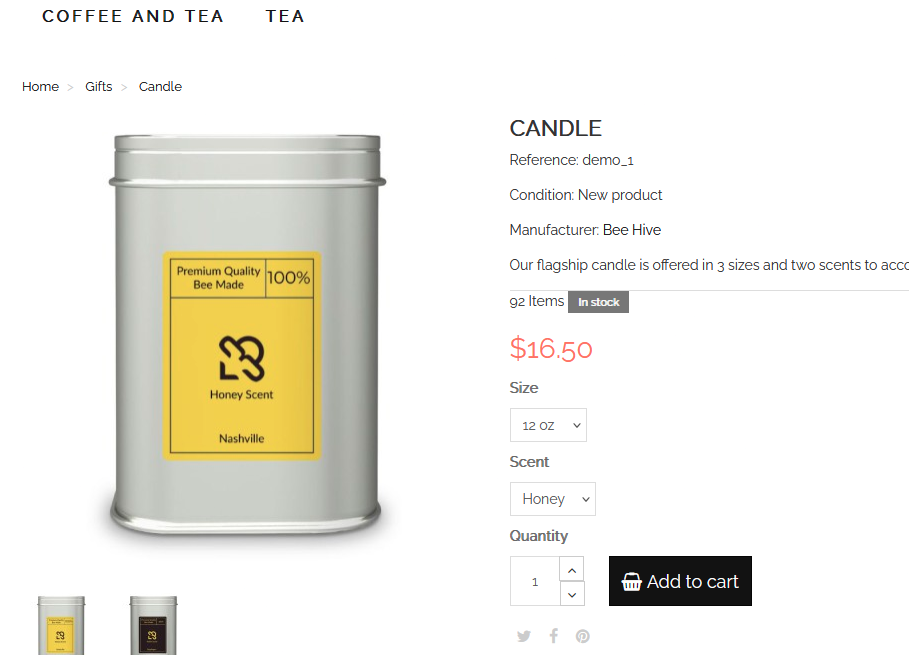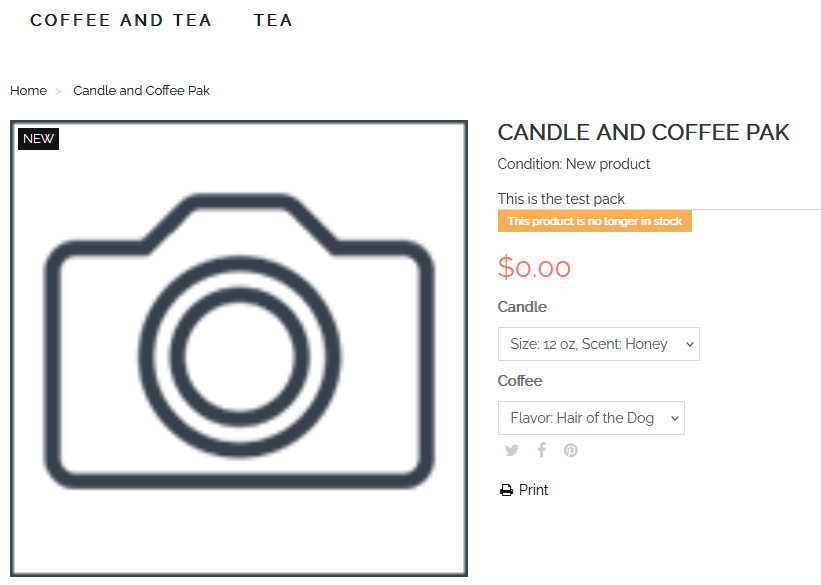-
Posts
496 -
Joined
-
Last visited
-
Days Won
26
Content Type
Profiles
Forums
Gallery
Downloads
Articles
Store
Blogs
Everything posted by x97wehner
-
I have the sku's setup to be pack specific. If you leave at per piece with a minimum, then customer can adjust to odd quantities. So, for instance, I have a product that is sold as 2pc. Then, I have packs of those two piece quantities at 12 and 24 as separate skus.
-
Also, it does appear you can still get your current module at https://www.presto-changeo.com/prestashop/prestashop-attribute-modules/34-113-prestashop-attribute-wizard-pro-module.html#/25-prestashop_version-all_versions_up_to_16x
-
I can't speak to the combination module, but I use the TB stripe module and it works well. I'm on TB 1.7 (One of the latest bleeding edge versions) and PHP 8.3.
-
Updated to fix abandon cart link generation issue with stock Brevo module.
-

free module Module to export products for Google Shopping
x97wehner replied to ukclearance's topic in Other native modules
It may be easier to just use this module. I've been using it for years. You can configure the feed and have it auto ingested by Google without you needing manually export and upload. https://store.getdatakick.com/en/modules/datakick-data-export-and-import -
Making progress here. Love it.
-
Eliminated some php warnings and adjusted to pull the product cover image (Rather than just the first one that is retrieved.)
-
Hi, I adapted Brevo's (Formerly SendInBlue) PS 1.7 version of their module to work on thirty bees and php 8.3. I didn't test on lower php versions, but it should work on php 8.0+ I believe. It connects and works and, for the price, they offer quite a bit of digital marketing functionality. Module is attached sendinblue_tb_v5.0.36.zip
-
Again, much appreciated. This is a great module for a variety of needs.
-
Your input has been incredibly helpful, but I'm still stuck on one situation that I hope you can advise on. For variants, our products typically offer many combinations but do not have specific photos. (Same product but different size. No extra photo needed.) Your advice on how to show this works correctly and it shows all photos related to the productId. The challenge is that we do have a handful of products that actually have specific combination photos (Different colors) and shouldn't show all photos from the product. I haven't figured out how to make the two settings work together for the additional image link node. If I set the restriction to combination photos, it only populates images for my handful of products with combination photos. If I set the restriction to all data, it shows all photos for the product, including for those products that have specific combination photos. (Red hat variant is showing red, but also blue, black, and all other color product photos.) Any advice on how to set this up to handle both scenarios?
-
Ah, that association was the gap I wasn't able to fix as our photos are not typically combination specific. This helps a ton. Thanks again!
-
Thanks @datakick. This is a big help. I'm still struggling on how to setup the variant version of this as well. It's not working so far no matter how I set it up. If you happen to know that and could share, that would be super helpful.
-

Which module do you use to integrate with FB and their ads API?
x97wehner replied to the.rampage.rado's topic in English
We use Datakick's module to submit data feeds. The ads themselves seem best managed within the meta ad tool. We've never connected the API for tracking yet, as we haven't found a good tool that will connect to TB yet. -
This override worked perfect. It no longer adds the inventory back unless the box is checked. Thanks.
-
I'm going to check this out. I agree, "Has been delivered" shouldn't even apply in this scenario and I'm guessing that is the problem. I'll let you know. Thank you.
-
Hi, I noticed this issue long ago and cannot figure out what would be causing it. The issue is this: - If I process a partial refund for an order from the back office, my system will always add the product back to inventory, even if I did not select the "Re-stock product" checkbox. It's quite frustrating since I do not want it added back unless I check the box. I've tested this on a clean install of TB and it does not have this issue. So then I went back and disabled all overrides and non TB modules on my system and cleared the cache. It still happens no matter what I do. I've checked the orderdetail.php file and it is exactly the same as the clean install file. Same with AdminOrdersController.php. What else could be causing this issue that I'm facing? If i have all non TB modules disabled as well as overrides off, it should work the same as my clean install of TB, right? Any help is appreciated.
-

Multiple tracking numbers for an order, needed or not?
x97wehner replied to the.rampage.rado's topic in English
It does allow separate couriers and tracking. -
This is a good start. While the backend is a bit clunky, i understand why you've built it this way. The challenge is on the front end, where the user isn't picking between the options to assemble the pack in the same experience that a standard combination product lays out on the same website. Standard layout, user picks size and scent from dropdown But on this new combination pack, the dropdowns are different and are just a consolidated list of every option possible. This might be okay for a small combination set, but is almost unusable for a large combination set. The best experience would be for the front end to allow for the same exact experience of assembling options for a combination similar to this site below. They sell each of the components (golf grip, shaft, head) independently and this is a discounted pack option with a range of prices displayed based upon the combination criteria. Until we're able to get a similar front end user experience between standard and pak products, this new feature would likely not be used by our store.
-

Multiple tracking numbers for an order, needed or not?
x97wehner replied to the.rampage.rado's topic in English
Real life for us: We often have to split shipments into multiple packages and between couriers. We have a third party shipping solution that helps us with this, but when looking in TB, all you see is one tracking code for once courier, which is wrong. Would be best if we understand in the TB backend which products were shipped against which tracking codes without having to jump to the other software solution to figure it out. -
Oh dear lord.... this will be awesome once its functioning correctly. I'll test and follow up.
-
Sharing this since I finally had time to look into the problem and figure out the issue of not all Stripe payment methods appearing on their hosted checkout page. If you're using the TB Stripe module, you likely noticed that with update to version 1.8 a while back, that you were no longer seeing all the payment methods you selected on your Stripe dashboard available in the hosted checkout page. This was a problem as we couldn't get Afterpay or Cash App to show up for customers to select. They are enabled on the Stripe dashboard, but not in the hosted checkout. Anyway, here is a band-aid fix until our TB dev's have time to properly adjust the module. You just need comment out a couple lines in the file StripeApi.php public function createCheckoutSession( Cart $cart, string $methodId, array $methods = [], array $paymentMethodOptions = [] ) { $context = Context::getContext(); $total = Utils::getCartTotal($cart); $validationLink = Utils::getValidationUrl($methodId); /* if (! $methods) { $methods = [ \Stripe\PaymentMethod::TYPE_CARD, ]; }*/
-
- 1
-

-
I'm on Warehouse on PHP 8.2 after some manual work to update. Not sure you'll be able to get it anymore though. I believe Panda is likely the most flexible theme available that is mostly configuration and not coding if that's what you're looking for https://www.sunnytoo.com/product/panda-creative-responsive-prestashop-theme . I'm not sure on their PHP compatibility but I remember them being quick to respond when asked. I believe I last tested it on 8.1 and it worked.
-
I realize this is an old thread, but it was relevant to me to remove invoice attachment in all scenarios, but still generate the document for customer access on the web, to ensure optimum email delivery with our domain (Since huge amounts of emails with attachments are a big spam flag). I resolved with this override based on a post I found on the web. (Don't judge my code please 😉) It takes an override of the PaymentModule.php file in classes/module/. Lines 695-698 below are modified. PaymentModule.php





